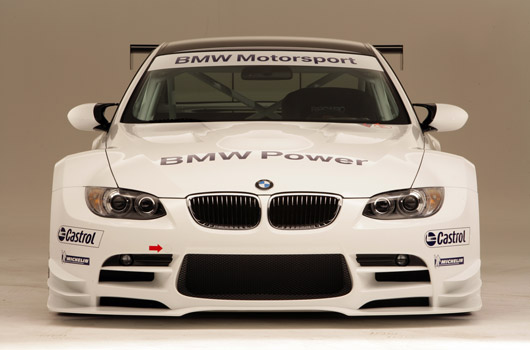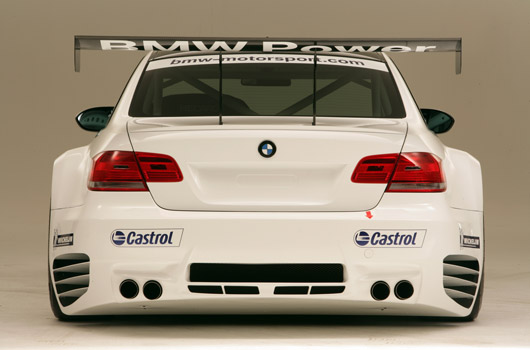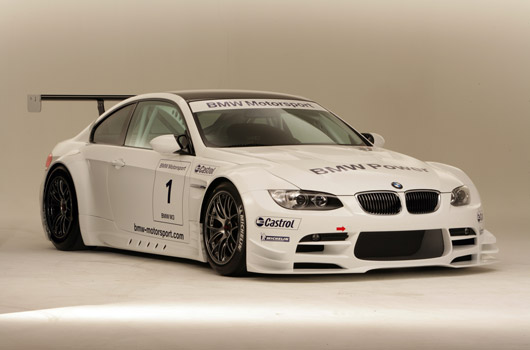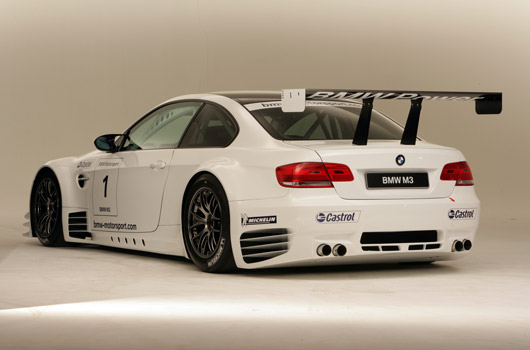Regular trawlers of motoring websites will know information on this BMW M3 race version is not new. This does not mean its late arrival on AUSmotive is any less worthy however. A replacement for the awesome BMW M3 GTR the new M3 race version is all set for the 2009 American Le Mans Series. Like the previous GTR one would expect this M3 to have a crack at the Nürburgring 24 hour race in 2009 as well. Enjoy this clip above from bmw-web.tv before going all ga-ga over the glory of the images below (click each pic for a 2000px super image). Just look at it! There’s also enough technical data in BMW’s press information to keep anyone happy.
Clear the decks for the race version of the latest generation BMW M3
Chicago/Munich, 6 February 2008. BMW presented the racing version of the new BMW M3 at the Chicago Auto Show. Powered by a 485 bhp eight cylinder engine, this impressive race car has been designed to compete in the American Le Mans Series (ALMS) from 2009 onwards. The car is based on the fourth generation of the BMW M3, the high-performance sports car produced by BMW M GmbH.
BMW Motorsport Director Mario Theissen says: “With the sporting genes of the production BMW M3 being clearly evident, developing a racing version of the car was the next logical step. The fact that the road-going vehicle is fitted with a V8 engine as standard provided us with an ideal base. However, the BMW M3 is more than a race car, it has achieved legendary status amongst race fans across the globe. I am convinced that this unique story of the BMW M3 racing cars will now be expanded upon by the addition of further chapters.â€
“We are very pleased to be returning to the American Le Mans Series with our latest generation BMW M3,†states Tom Purves, Chairman and CEO, BMW of North America. “Sports car racing has been part of BMW of North America’s history practically from day one. Just two weeks after the company was formed in March 1975, a BMW CSL won the 12-hours of Sebring. We are confident that the fourth generation M3 will continue the legacy of its two predecessors which combined to win six manufacturer’s championships over nine seasons. As it has been in the past we believe the ALMS is the ideal venue to showcase the potential of the newest BMW M3.â€
BMW’s 2009 entry into the Sports Car Championship will be overseen by the United States-based Team Rahal Letterman operation. “BMW has an illustrious racing heritage,†says co-owner and US motorsport legend Bobby Rahal. “Rahal Letterman Racing is eagerly anticipating, not only becoming part of that heritage, but helping to enhance it. Our dedication to this project will be without equal and we look forward to racing at the front of the grid with BMW in the years to come.â€
The BMW M3 Race Version: Sportiness personified
In the course of developing the race version of the BMW M3, BMW’s engineers were faced with an ambitious task: to improve upon the sportiness of an already sporting car. A better base would, though, be difficult to find. In standard form the vehicle delivers powerful dynamics and sporting aesthetics. Thanks to an eight cylinder engine producing 420 bhp, BMW’s customers are provided with a unique driving experience.
Those engine blocks, cast in BMW’s light alloy foundry in Landshut – the very source of BMW’s Formula One castings – selected for race duty need to withstand even more power: the BMW P65 engine delivers 485 bhp.
In order to enable the BMW M3 to make full use of this performance on the race circuit, the experts in Munich have not concentrated solely on the engine, but have race-tuned the chassis as well. The race version of the BMW M3 is wider and significantly lighter than its production equivalent, enabling it to perfectly transmit the power of its V8. Widespread use of carbon-reinforced plastic (CRP) provides proof of substantial weight reduction. As with the production version, the race car’s roof is manufactured from this high-tech material.
The race version of the BMW M3 is clearly aimed at the top echelon of motorsport. As such, it is no surprise to discover that in the course of its development, begun in mid-2007, numerous Formula One techniques were applied. These include computational fluid dynamics (CFD) and wind tunnel analyses, both of which have ensured the best possible aerodynamic package for the BMW M3.
Intelligent control systems have been incorporated throughout the BMW M3. The POWER400 control unit actuates all the accessories fitted to the car, such as lights, wipers, etc., via two bus systems. Traditional relays and fuses are thus eliminated, ensuring considerable weight saving, improved reliability and ease of application. The functions of the BMW P65 engine are managed by an ECU 408 electronic control unit, developed in-house by BMW Motorsport. The software and applications, too, have been developed by the experts in Munich.
Return to familiar territory
An intensive test program, during which the performance of the race car will be honed by BMW Motorsport, looms for the BMW M3 over the coming months. Development drivers will be BMW works drivers Andy Priaulx (GBR), Jörg Müller (GER) and Augusto Farfus (BRA), currently racing in the FIA World Touring Car Championship (WTCC). The aim is, after all, for the BMW M3 to be an immediate front-runner upon its comeback to the American Le Mans Series.
BMW can look back on numerous successes and titles in the ALMS. In 1999 and 2000 the BMW LMR V12 scored six prototype victories. For 2001 BMW switched to the GT Class, winning everything in sight with the BMW M3 GTR, which was developed specifically for the ALMS: BMW works driver Jörg Müller claimed the drivers’ championship, Team BMW Motorsport took the team title and BMW won the manufacturers’ championship in the company’s most important export market.
Rahal Letterman Racing made its debut in the ALMS in 2007, immediately laying claim to podium places in the GT2 category. The 2008 season gets under way, as has become traditional, with the Sebring 12 Hour Race on 15 March.
BMW in the American Le Mans Series
The American Le Mans Series is far from virgin territory for BMW. During both 1999, the series’ inaugural season, and the following year, the company celebrated major successes in North America. Under the management of the Schnitzer Team’s Charly Lamm, five BMW drivers scored a total of six victories with the 580 bhp BMW V12 LMR. In 1999 the impressive BMW V12 LMR simultaneously won the very race which served as inspiration for the ALMS: the Le Mans 24 Hour Race.
In 2001 BMW deployed a new car. For the third ALMS season a switch was made from the Prototype category to the GT class using the BMW M3 GTR, a totally new development powered by an eight cylinder engine delivering 450 bhp. Two operations, Team BMW Motorsport from Germany and the US-domiciled BMW Team PTG, entered two cars each. The Team BMW Motorsport entries were driven by Jörg Müller/JJ Lehto and Fredrik Ekblom/Dirk Mller respectively, with Hans-Joachim Stuck and Boris Said, and Niclas Jonsson and Bill Auberlen doing driver duties in the Team BMW PTG Team-entered cars.
The debut season of the BMW M3 GTR rapidly became a success story: BMW drivers mounted the top step of the podium seven times, with six pole positions falling their way. BMW works driver Jörg Müller captured the drivers’ title, Team BMW Motorsport took team honours, and BMW the manufacturers’ championship. After a development programme totalling less than six months BMW was able to lay claim to no less three championships with the BMW M3 GTR.
Ultimately successful 2001 season does not start to plan
The 2001 season did not, though, start to plan. At the opening race on 4 March in Fort Worth, Texas, the BMW M3 as raced during the previous year was deployed. Stuck and Said gave it their all, and placed third for BMW Team PTG. Approximately two weeks later things looked up: at the Sebring 12 Hour Race in Florida the BMW M3 GTR celebrated its track debut having undergone only cursory shakedown tests due to time pressures. However, Müller and Lehto immediately fired a shot across the bows of the opposition: they crossed the finish line of the classic race in third place, thereby ensuring BMW’s first podium place with the BMW M3 GTR. “That was the car’s first test drive under racing conditions,†said team manager Charly Lamm.
Team BMW Motorsport thereafter crossed the Atlantic in order to amass more experience by taking in two European Le Mans Series events of 2.45 hour duration each at Donington (Great Britain), and in Jarama (Spain). Although the team suffered a double retirement in England, the Jarama race ran totally to plan: Team BMW Motorsport celebrated its first one-two via Ekblom/Dirk Müller and Lehto/Jörg Müller. Both driver pairings raced the new BMW M3 GTR.
They’re unleashed
After its European sojourn, Team BMW Motorsport returned to the USA. Together with Team BMW PTG, Charly Lamm’s operation fought for points and placings at California’s Sears Point Raceway. Lasting almost three hours, the race culminated in a quadruple success for BMW: Lehto/Jörg Müller won from Said/Stuck, with Ekblom/Dirk Müller and Auberlen/Jonsson following them across the line. The next race, at Portland, Oregon, saw Said/Stuck win, with Team BMW Motorsport taking third and fourth places.
The extent of the domination of the BMW teams became clear during the final four rounds of the series: in Mosport (Canada), Mid-Ohio and Laguna Seca Lehto/Jörg Müller won from Ekblom/D Müller; the season finale, the ‘Petit Le Mans’ at Road Atlanta, saw Auberlen/Said/Stuck win. Dirk Müller and Jörg Müller placed second.
Thus the BMW teams ended the 2001 AMLS season with four consecutive one-two victories. BMW drivers mounted the top step of the podium seven times, with Jörg Müller celebrating the most: he amassed 185 points to take the drivers’ title by five points from team-mate JJ Lehto. The teams’ classification was won by Team BMW Motorsport (184 points), with BMW Team PTG placing third with 170. The Manufacturers’ Championship went to BMW with 198 points.
In total the BMW teams had contested ten races each. For Team BMW Motorsport in particular, participation in the series proved a major logistical challenge: the team travelled 11,000 kilometres within Europe and a further 45,000 kilometres in North America as its crew travelled from race to race. A regular paddock and permanent workshop facilities were as sorely missed as were home town comforts.
“The technicians, the teams and the drivers performed magnificently,†said BMW Motorsport Director Mario Theissen after the season finale. “The late project start, combined with the logistical challenges of the North American races, made it extremely demanding.†The effort was, though, justified: the BMW M3 GTR came through its baptism of fire with flying colours.
Technical Specifications BMW M3 Race Version
Weight: 1150 kg
Tank capacity: 110 Liter
Chassis/body: Unitary construction steel body with welded safety cell made of extremely rigid precision steel tubing; safety fuel tank in CRP sandwich tray; pneumatic four-stamp jack system
Aerodynamics: Front wings, rear apron, motor hood, roof, trunk lid, rear wing, front wings, and flared rear wheel arches in CRP
Transmission: Carbon fibre clutch operated by hydraulic central slave cylinder; 6-speed sequential racing transmission with straight-cut, unsynchronized gears; additional oil/air cooler; quick shift system with ignition cut-out controlled by shifting force; mechanical limited slip differential with additional oil/air cooler
Front axle: Based on production version, with increased wheel caster angle, enlarged track width and enhanced wheel camber; five-way adjustable shock absorbers; tubular stabilizer bar
Rear axle: Based on production version, with enlarged track width and enhanced wheel camber; five-way adjustable shock absorbers, tubular stabilizer bar
Front brake system: Six-piston aluminium brake calipers, inner-vented grey-cast iron brake disks 380mm in diameter
Rear brake system: Four-piston aluminium brake calipers, grey-cast iron brake disk, 332mm in diameter
Steering: Rack and pinion steering with electro-hydraulic power
Wheels: Aluminium wheels, 18 inches
BMW P65 Engine
Type: Eight cylinder, V-configuration
Capacity: 3999 cc
Bore x stroke: 92 x 75.2 mm
Max. output: approx. 485 bhp
Max. torque: approx. 500 Nm
Cylinder block: Aluminium cylinder block construction with bed plate lower section
Crankshaft: Steel crankshaft
Pistons: Forged skirt pistons
Conrods: High-performance steel
Cylinder head: Aluminium DOHC (Double Over Head Camshaft): four valves per cylinder
Valve train: Four overhead chain-driven camshafts, valve actuation via rocker arms
Intake system: Eight throttle valves, made of CRP with load-charge optimized ram tubes
Exhaust system: Headers, silencer
Fuel system: Single cylinder multi-point injection
Lubrication: Dry sump lubrication
Cooling: Water/air cooler and oil/water heat exchanger
Electrics/Electronics
Engine management: BMW Motorsport ECU 408 with two high-performance micro-processors; Individual cylinder injection and ignition; BMW Motorsport Lambda Controller; Pit speed limiter, Quick Shift function; Engine data memory system
Energy management: Electric energy management and monitoring with BMW Motorsport POWER400 control unit, networking of all sensors and actuators through bus system
Wiring harness: Weight optimized
Ignition coil: Eight high-performance pencil coils with integrated ignition drivers
Spark plugs: High-performance spark plugs
Cockpit: Free programmable LCD Display with integrated shift indicators
Steering wheel: Quick release multi-function steering wheel with integrated display unit




9 replies on “BMW M3 race version”
“Regular trawlers of motoring websites will know information on this BMW M3 race version is not new. This does not mean its late arrival on AUSmotive is any less worthy however.” – AUSmotive
All you have done is made it ‘official’! 😛
Haha, that’s right.
[…] expected the Z4 GT3 car is powered by a 4.0 litre V8 sourced from the M3 GT2. It’s good for more than 480bhp. Other technologies and developments from the Gt2 have been […]
[…] of the info seems to indicate the App will follow the M3 GT2 most closely. But would also expect the new Z4 GT3 to be covered as […]
[…] #25 BMW M3 GT2 driven by Jörg Müller, Augusto Farfus, Uwe Alzen and Pedro Lamy has won the Nürburgring 24 hour […]
[…] year’s Nürburgring 24 hour race was won by the #25 BMW M3 GT2 driven by Jörg Müller, Augusto Farfus, Uwe Alzen and Pedro Lamy. It was Lamy’s fifth […]
[…] bhp on new bmw m3 ausmotive.com […]
[…] bmw m3 gtr race version ausmotive.com […]
[…] bmw raceing ausmotive.com […]